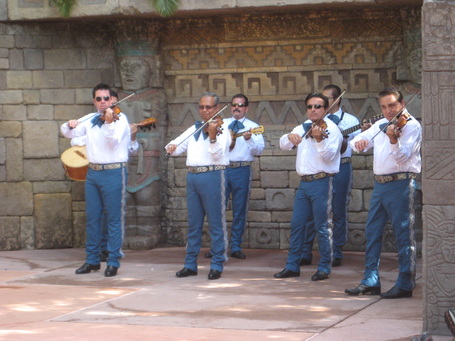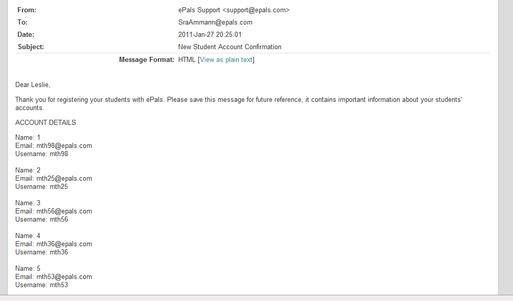How to Register
Where: ePals
When: April/May of current school year
Deadline: August of next school year (3-4 month window to register)
Information to Include: number of students in class, willingness to share information, contact information, commitment to the project, functioning technology and Internet available, and expectations of the project
Activities

Personal photo: cincodemayo.jpg
- Observation: Observation should occur during each set of projects. Each teacher should take some notes so that they are prepared to fill out the mid-year and end of the year project evaluations.
- Discussion/Analysis: Discussion and analysis of the project can be done through the evaluations as well as available to answer questions about the project, open to ideas as to how to improve it, and to troubleshoot if technology is becoming problematic.
- Creation/Synthesis: Although I would be responsible for creation of the entire project, I am open to collaboration of ideas and resources. Creation includes establishing the ePals account and project, creating training and evaluations, helping find resources for holidays in other countries, and keeping an open discussion throughout the project.
- Evaluation: Evaluations will be completed mid-year and at the end of the year to evaluate the effectiveness, time frames, quality, and communication of the project. Please see the Google form associated with this telecollaborative project.
Time Commitment and Schedule of Activities

Photo from: http://www.flickr.com/photos/travlinman43/3674530629/
Project Span: Start—Fall of school year → End—Spring of school year
Schedule of Activities
Prior to beginning the project, students in both countries would be divided into four groups. Students in the United States will be researching more about the holidays in the U.S. in order to provide accurate information to the students in Mexico. The students in Mexico will do the same, but they will be researching their own holidays. Students will complete research on their own country first because the reality is that not every student knows background information regarding their own country’s holiday or has even celebrated it. Students will then post this information for the students in the other country in order to begin their multimedia presentations. Students will have the opportunity to exchange information, media elements, and ask questions. Each student will only research and present on one holiday. Although the projects begin in the fall, only a handful of students will be working on their projects at one time (see the timeline below).
The following questions should be answered by each group:
1. What is the holiday/celebration?
2. Why is it celebrated?
3. How is it celebrated in your country (i.e. parties, church, presents, games, activities, songs, etc..)?
4. What is eaten during the holiday/celebration?
5. Does everyone in the country participate? Why or why not?
6. What is the historical context of this holiday?
7. Does it have religious or cultural context? If so, what is it?
8. Are there any myths or stereotypes surrounding the holiday? What are they? Are they actually true?
9. What do the pairs of holidays have in common? Are either similar to any other holiday celebrated in within our culture or another?
10. Share any personal experiences related to this holiday?
11. How are the pairs of holidays similar and different? Why do you think they are similar and different?
12. What else would you like to discover about this holiday?
All groups will research their own country’s holiday first, post their information/media for the other country, and then…
o October 15-November 15: Día de los Muertos(Day of the Dead)/Halloween
United States Activities: Students in Group #1 will research Día de los muertos, correspond with students in Mexico to obtain information, media, and personal experiences in order to present their findings to the class. Students will need to research both Day of the Dead and All Saints Day, discover the religious and cultural contexts, and the influence of food on this holiday.
Mexico Activities: Students in Group #1 will research Halloween, correspond with students in the United States to obtain information, media, and personal experiences in order to present their findings to the class.
Students will need to discover the religious and cultural contexts of this holiday, why children trick-or-treat and dress in costumes, and the significance of candy on this holiday.
o December 15-January 15: Día de los Reyes Magos(Three Kings Day)/Navidad (Christmas)
United States Activities: Students in Group #2 will research Día de los Reyes Magos, correspond with students in Mexico to obtain information, media, and personal experiences in order to present their findings to the class. Students will need to determine why this holiday is much more prominent in Mexico than Christmas, the religious and cultural contexts, why shoes were chosen as a means to collect gifts, and the importance of the three kings.
Mexico Activities: Students in Group #2 will research Navidad, correspond with students in the United States to obtain information, media, and personal experiences in order to present their findings to the class. Students will need to determine the religious and cultural differences between the various celebrations, what other holidays fall around Navidad and how they differ, and the importance of Santa Claus and Jesus.
o February: TEACHER EVALUATIONS OF PROJECT AND EPALS (see evaluation page)
o March 15-April 15: Día de los Inocentes(Day of the Innocents)/April Fool’s Day
United States Activities: Students in Group #3 will research Día de los Inocentes, correspond with students in Mexico to obtain information, media, and personal experiences in order to present their findings to the class. Students need to determine the religious and historical contexts of this holiday, the slaughter of the innocents, how it has turned into a comical celebration, and the kinds of tricks that are common practice.
Mexico Activities: Students in Group #3 will research April Fool’s Day, correspond with students in the United States to obtain information, media, and personal experiences in order to present their findings to the class. Students need to determine the cultural and historical contexts of this celebration, why it is celebrated, the kinds of tricks that are common practice.
o April 15-May 15: Cinco de Mayo(May 5th)/Día de la Independencia (4th of July)
United States Activities: Students in Group #4 will research Cinco de Mayo, correspond with students in Mexico to obtain information, media, and personal experiences in order to present their findings to the class. Students will determine the historical and cultural contexts of this holiday, the real independence day, how it affects Mexico and the United States, and the traditional celebrations that occur.
Mexico Activities: Students in Group #4 will research Día de la Independencia, correspond with students in the United States to obtain information, media, and personal experiences in order to present their findings to the class. Students will determine the historical and cultural contexts of this holiday, how it has affected the world (but mostly England), and the traditional celebrations that occur.
All four projects will conclude with multimedia group presentations about their new holiday in each country using PowerPoint, Glogster, or other approved medium supporting video and/or sound and pictures. See the rubric in order to view specific project requirements.
o June: TEACHER AND STUDENT EVALUATIONS OF PROJECT AND EPALS (see evaluation page)
o June: Thank all participants and decide whether or not to continue the project the following year.
o June-August: Advertise and gather participants for the following school year, provide training and answer questions, and redesign materials as needed.
Project Closure
Where: Mexico and the United States
When: May/June
Deadline: project completion by the close of the school year
Information to Include: teacher evaluation of the project and ePals, student project evaluations, thank-you notes sent to project participants, and final presentations of each group saved as examples for future projects
Project Expansion
Where: ePals, but accepting more pairs of classes
When: the following school year, continuing until project interest wanes or teacher involvement lessens
Deadline: similar deadlines year to year if the project evaluations are positive and suggested changes to the project are manageable
Information to Include: changes in technology as technology advances or changes, more pairs of holidays so that project groups are smaller, other methods of contact and communication if ePals no longer meets the needs of the students and teachers

